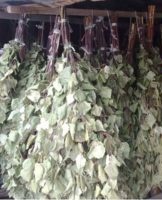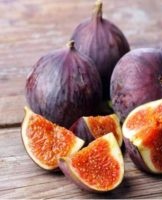How to store tomatoes at home, rules, duration and methods
There are many ways to store tomatoes. To extend the shelf life of the crop, you need to know how to properly store tomatoes and how to prepare them.
Content
- 1 Preparing for storage: general guidelines
- 2 What varieties are suitable for long-term storage
- 3 Rules and shelf life of tomatoes
- 4 How to properly store tomatoes
- 5 How to speed up the ripening of unripe picked vegetables?
- 6 How to extend the shelf life of vegetables
- 7 What if the tomatoes start to spoil?
Preparing for storage: general guidelines
Before leaving the harvested crop for storage, it is necessary to carry out a number of preparatory steps. Including:
- Inspect the vegetables and discard any cracked, rotten, or misshapen specimens. Ripe and overripe tomatoes are best sent for processing or eaten fresh.
- Sort the harvest by variety and size. The storage temperature is different depending on the species, and large tomatoes ripen faster than small ones.
- Wash the fruits and let them dry well so that the rotting process does not start during long-term storage.
- Cover the tomatoes with a protective sheath.A thin layer of wax or a low-strength gelatin solution helps keep vegetables fresh.
What varieties are suitable for long-term storage
Among the variety of tomato varieties, not all of them have the ability to retain their flavor and freshness for a long time. Which variety is suitable for storage should be determined when choosing seeds or seedlings. Considering the specifics of weather conditions, it is recommended to select varieties zoned for a specific climate. For long-term storage, the most suitable varieties are Long Keeper, Rio Grande, Masterpiece, Podzimny, Khrustyk F1 hybrid.
Rules and shelf life of tomatoes
Depending on where the crop will be stored, it is necessary to create suitable conditions. Cool rooms with low humidity are most suitable for tomatoes.
In the fridge
When you use the refrigerator to store fruits, put them in the crisper where the conditions are right to extend the shelf life. Tomatoes should be laid out in 1-2 rows so as not to create pressure on the lower vegetables.
Faced with the question - whether or not it is better to leave tomatoes on the refrigerator shelf, it is worth choosing a specialized compartment for storage, if possible. If it is possible to keep tomatoes only on the shelf, then you need to wrap them in plastic bags.
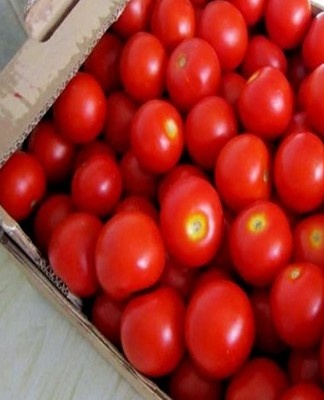
In the basement
The basement for crop storage should be clean and cool. The shelf life of the fruit directly depends on how many degrees there will be in the cellar. The optimum temperature in the basement can be up to 12 degrees, the humidity indicator is 80-90%. If the room is too humid, the tomatoes will mold, and too dry air will wrinkle and dry out the crop.It is also recommended to periodically ventilate the room to circulate the air.
On the balcony
At home, it is allowed to store crops on the balcony at temperatures from 5 to 12 degrees. It is enough to lay out the fruits in peeled wooden boxes, at the bottom of which a thick cloth or paper is covered. You also need to make liners between each layer of vegetables. The boxes can be stacked on top of each other and the top can be covered with a cloth to prevent direct exposure to ultraviolet rays.
It is important that the shelter does not obstruct the passage of air.
At room temperature
Many gardeners keep the harvested crop in an apartment and often wonder at what temperature the vegetables will not deteriorate. For unripe fruits, the maximum temperature is 20 degrees, otherwise they will be overripe and rot. Ripe specimens require a temperature of no more than 7 degrees.
Vegetables should be checked regularly for spoilage throughout the shelf life. By separating rotten fruits in time, it will be possible to preserve the freshness of the rest of the crop.

How to properly store tomatoes
Different storage conditions are suitable for fresh, unripe, dried and other tomatoes.
In order to preserve the quality, appearance and taste of the fruit, the specificities of each type must be taken into account.
Mature
The optimum temperature for ripe tomatoes is 4-6 degrees Celsius. You can put ripe vegetables in the refrigerator or in drawers. It is recommended to use the crop for fresh consumption or processing a few weeks after harvest.
Red fruits
It is recommended to store red tomatoes in shallow boxes, stacked with the stems up in 2-3 rows. Between the rows you need to pour sawdust and cover the containers with a thin plastic wrap, able to let in fresh air. They contain red tomatoes at a temperature of 1-2 degrees for up to a couple of months.
brown tomatoes
The brown variety of tomatoes is placed in wooden boxes of 10-12 kg each. To prevent the fruits from touching each other, they can be wrapped in thin paper. The boxes are covered with a lid and kept at a temperature not exceeding 6 degrees.
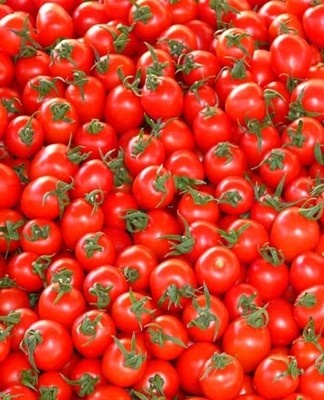
Milk and green vegetables
In order for milk tomatoes to ripen, they must be left in a room at a temperature of 15-20 degrees. At higher temperatures, the vegetables will not produce coloring matter and will taste less juicy. Periodically it is worth inspecting the culture and selecting ripening specimens.
Storing processed tomatoes for the winter
Processed vegetables can also be stored over winter. Considering the processing method, it is important to observe the peculiarities of the storage conditions.
Dried foods
It is recommended to store ready-to-use sun-dried tomatoes in tight cotton bags. You can also preserve taste and freshness by using a food container with a sealed lid as a container. When placing sun-dried vegetables in a container, you must first pour olive oil into it. The container is placed in the refrigerator or freezer, but it should be remembered that when thawing the vegetables will lose their original color.
Dried tomatoes
Dried fruits can, by analogy with dried fruits, be packed in cotton bags or placed in sterilized glass jars. If desired, add garlic, pepper, salt and other spices to the container. Then vegetable oil is poured into the jar, and the neck is covered with plastic wrap and a sealed lid.
It is allowed to store dried vegetables in wooden or plywood boxes, cardboard boxes and wicker baskets. Several layers of paper are aligned at the bottom of the containers and placed in a cold room at a temperature of 0 to 10 degrees.
canned tomatoes
Canned tomatoes are stored at room temperature in a dark place or in a pantry. The maximum shelf life is 12 months. If the term is violated, an oxidative reaction may begin and the crop will lose its taste characteristics.
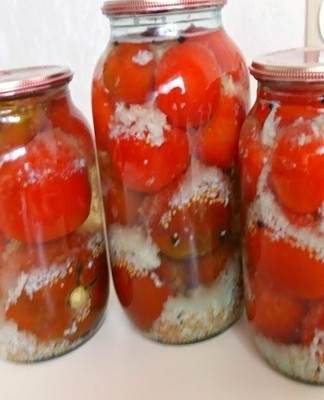
How to speed up the ripening of unripe picked vegetables?
Premature frosts and other circumstances do not always leave the opportunity to wait until all the tomatoes are fully ripe. After harvesting green fruits from the garden, you need to use various methods to ripen the crop at home.
In order for the tomatoes to turn red faster, you can remove the bushes from the ground with the roots. Then the plants are hung from the ceiling with their roots up so that the fruits continue to receive nutritional components for some time. In addition, there are several ways to leave the fruits removed from the bushes to ripen. For this, it is necessary to create favorable environmental conditions and additionally apply developmental stimulants.
Vodka
During numerous experiments, the effect of ethyl alcohol on the ripening process of vegetables was studied, which led to a positive result.Injection with a syringe of 0.5 ml of vodka into a green tomato through the base of the stem accelerates ripening by 14-16 days. Vodka injected into the fruit decomposes and does not affect the taste and chemical composition. Seeds of tomatoes, in which alcohol is introduced, are suitable for further cultivation and do not need to be processed in a special order in order to get good sprouts.
Ethanol
By analogy with the introduction of vodka into fruit, injections of ethanol can be used to accelerate ripening. For a 100 g tomato, 150 mg of ethanol is used at a concentration of 50 to 95%. Due to the effect of the substance, ripening is accelerated by 10-14 days. The chemical composition of the vegetables, the ripening of which is stimulated by the injection of ethanol, remains practically unchanged. The seeds of the injected vegetables have a good germination rate and form healthy plants.

heat and light
Allowing harvested tomatoes to ripen until they turn red at home is important for creating a favorable environment. Tomatoes of technical ripeness, which have not yet acquired a red tint, ripen more actively in the heat and with good lighting. The best way is to spread the fruit on a heated windowsill, where natural light enters throughout the day.
It is not recommended to leave vegetables of different maturity to ripen in the same place. The best result is obtained if the crop is sorted in advance.
In order for vegetables to retain their high taste and juiciness during the ripening process, it is necessary to ensure the presence of ethylene gas. The substance is actively secreted by all ripe fruits and vegetables.To increase the ethylene concentration next to vegetables left to ripen, it is recommended:
- put several well-ripened specimens on the tomatoes;
- add ripe apples or bananas to the crop;
- cover unripe fruit with a cloth.
Red color
The impact of the red color has a positive effect on the maturation of the crop. Next to unripe fruits, you can leave not only red tomatoes, but also red tissues.
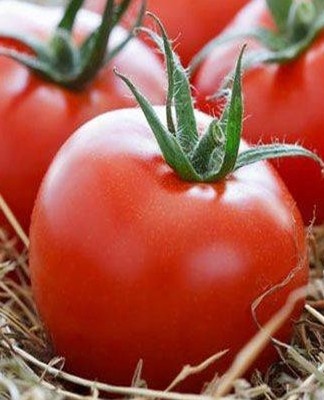
How to extend the shelf life of vegetables
There are several ways to extend the maximum storage period of a culture. One of them is the inhibition of the ripening process of tomatoes. To keep them longer and not deteriorate, you need:
- Pick only green vegetables, but after they have reached the size corresponding to the cultivated variety.
- Store containers with fruit in a constantly ventilated area with limited lighting.
- Allow for a temperature of around 12 degrees for fully green fruits, 6 degrees for browns, no more than 2 degrees for pinks.
- Regularly inspect crops and sort mature specimens.
- Check the humidity indicator, not exceeding the 85% mark. If the humidity is too low, the fruits dry out and otherwise they begin to rot.
Full compliance with the listed rules will allow tomatoes to be stored for a long time when ripe.
If it is necessary to extend the shelf life of picked vegetables, which have had time to fully ripen on the bushes, it is enough to create a favorable microclimate.
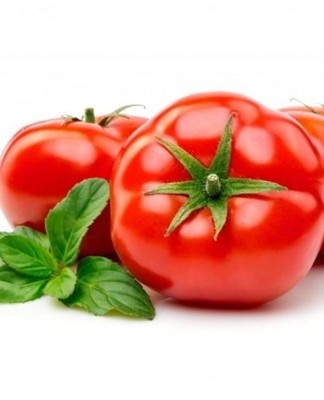
What if the tomatoes start to spoil?
Overripe fruits soften, their shells crack, and the flesh begins to rot. These fruits will not make a fresh salad, so they can be used for other culinary purposes. For example, tomatoes can be peeled and finely grated.Adding garlic, herbs, pepper and salt to the resulting mixture, you get a sauce with which you can season various dishes.
You can also make oil from tomatoes that have started to go bad. First, you need to bake the vegetables in the oven a little, carefully remove the skin and cut the stalk. Peeled fruits are placed in a blender, butter, salt and herbs are added. The mixture is carefully whipped, then stored in a cool place for 1-2 weeks. The resulting oil can be added to dishes or spread on bread.
If it is not possible to immediately process the tomatoes, then it is permissible to freeze them and use them in the future. Before freezing, the vegetables are washed, the rotten parts are cut out and dried. Then the fruits are put in plastic bags and left in the freezer. After planning to process the harvest, you need to get the tomatoes, wait for them to thaw completely, remove the skin and use as directed.


